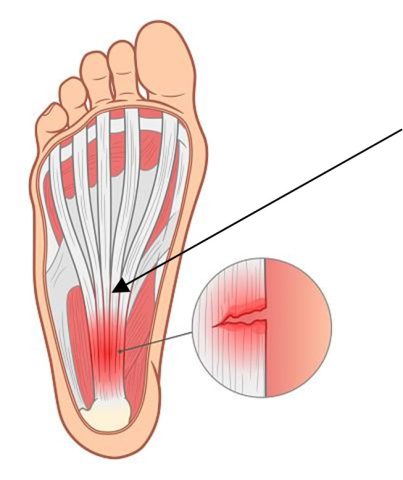Fussing with Fascia
Fussing with Fascia
Common Running Injuries – Part 4
Hello again! Welcome to part 4 of our running injuries series. We will be talking about plantar fasciopathy, aka plantar fasciitis or plantar heel pain. This is an injury that typically affects - you guessed it - lots of runners! Let’s dive in!
What is Plantar Fasciitis?
The plantar fascia is a band-like structure that runs from the bottom of your heel and branches out to the bottom of the toes, as seen in the photo below.
Plantar fasciitis causes pain around the bottom of the heel and arch of the foot. It can vary in size of area affected and is usually described as a sharp stabbing or burning pain. Plantar fasciitis is a condition that has been found to affect up to 8% of the entire running population!

Other structures around the heel may also cause similar symptoms to plantar fasciitis, so it is important to get a proper assessment from a physiotherapist or chiropractor to clarify what the appropriate treatment plan is for you. Here are a few examples of other conditions that may present similarly:
- Heel fat pad syndrome
- Heel spurs
- Achilles tendinopathy
Pain is likely to diminish and settle down when resting and not weight-bearing. But will commonly be reaggravated with the first few steps after a period of rest. Several examples include:
- Getting out of bed first thing in the morning (may feel sharp jabbing pains) **
- Standing up and walking after prolonged sitting
- Standing for long periods in a stationary position
- Commonly, first step pain will be described as “walking on glass or needles”
Common Risk Factors
- Sudden Increase in activity and training regime (overload) *
- Training time (increased duration)
- Change in footwear
- Weight gain
- Lots of running in general
- High impact sports e.g. basketball, soccer, volleyball
- Limited or decreased ankle and first toe mobility
These are just a few of the many risk factors that may contribute to plantar fasciitis. Increased stress from work, or life in general may also increase the likelihood of injury. Below we will discuss how to best treat and manage plantar fasciitis.
How Do Physiotherapists Treat Plantar Fasciitis?
Appropriate rehabilitation professionals such as Physiotherapists and Chiropractors may provide education, soft tissue treatment, specific exercises, orthoses, taping, and many other options to target your foot and heel pain.
The current evidence suggests a combination of load management, resistance training, stretching, and taping to be the optimal treatment for plantar fasciitis. For long-term effects, exercises appear to have the most benefit in improving function and decreasing pain. During the short-term, corticosteroid injections combined with exercise may be beneficial. This should be discussed with your healthcare provider and physician to allow an informed decision for your unique situation. It is important to keep in mind that consistent steroid injections can actually reduce the integrity of the fascia and surrounding structures. Thus, weakening it and leading to a greater risk of injury.
Extracorporeal shockwave is another useful tool if the injured area has not responded to the initial exercises and has persisted for an extended period of time with minimal to no improvement. You can learn more about shockwave therapy here. Additionally, orthotics may be of use if exercise and load management have not reduced the amount of pain you are experiencing. These do not necessarily have to be customized; however, a discussion with a physiotherapist or another appropriate healthcare provider will assist in the decision-making process.
Exercises to gradually load the plantar fascia have previously been found to be quite helpful. The most effective exercise demonstrated in the current research is an exercise targeting something called the windlass mechanism. This essentially places the plantar fascia under tension/stretch while performing certain movements. You want to ensure that your toes are elevated on a towel to fully tension the plantar fascia. This way, you will get the most benefit out of the exercise.
Exercises to Relieve Pain from Plantar Fasciitis
Here are some exercises you can try at home, they just might help you reduce your pain! Begin with 12 repetitions of the windlass heel raise exercise 2-3 times a week to allow your body time to adjust. The other exercises are supplemental, so if you only have time to do one… do the windlass heel raise!
You may find you get a little soreness after your exercises. This is totally normal, especially if you haven’t done a lot of exercise recently. It should settle down after a few days and get easier over time with more consistency.
The exercise load should be progressed gradually over several weeks. As the amount of weight goes up, the repetitions should go down. For example, when the weight is increased after 2 weeks, the number of repetitions should go down to 10. After another 2 weeks when the weight is increased yet again, the repetitions should go down to 8.
Listed below are three exercises for plantar fasciitis, based off the most recent physical rehabilitation evidence and research:
Windlass Heel Raises
Start with bodyweight and add load accordingly. Aim for 2 sets and 12 reps with this exercise. You can try to add more resistance by putting weights in a backpack or holding weight in your hands.
Key Point: The windlass exercise should be done in a slow, controlled manner. 3 seconds up, 2 second pause, and 3 seconds down. This will reduce the likelihood of over aggravating the tissues.
Ecc DL Heel Raise
Aim for 2 sets and 12 reps for this exercise.
Plantar Fascia Stretch
Aim for 2 sets that are 10-20 second holds and 10 reps with this exercise.
Post Tib Inversion
Aim for 3 sets of 15 reps for this exercise.
As always it is important to stay within your limitations and comfort levels. Start slow and if you are unsure, feel free to reach out to one of our Physiotherapists.
Plantar fasciitis is a common and treatable condition. I hope all you athletes, weekend warriors, and runners found this information useful! If you have any further questions, feel free to contact us or you can book an appointment online by clicking here.
About the Author
Jason Chung, MSc PT, BKin, NSCA-CSCS
Email: jason@strivehealthandperformance.ca

Jason Chung is an Interim Physiotherapist and NSCA certified strength and conditioning coach at Strive Health and Performance. Jason is currently pursuing advanced training in musculoskeletal assessment and rehabilitation to better assist his patients with their recovery. He is also undergoing training through the Sport Physiotherapy Canada credentialing program to improve his knowledge in sport specific injuries. In his spare time, you can find Jason on the golf course, trying for those ever-elusive birdies, hiking or hanging out with family and friends.
References
Babatunde, Opeyemi O et al. "Comparative Effectiveness Of Treatment Options For Plantar Heel Pain: A Systematic Review With Network Meta-Analysis". British Journal Of Sports Medicine, vol 53, no. 3, 2018, pp. 182-194. BMJ, doi:10.1136/bjsports-2017-098998. Accessed 5 July 2021.
Morrissey, Dylan et al. "Management Of Plantar Heel Pain: A Best Practice Guide Informed By A Systematic Review, Expert Clinical Reasoning And Patient Values". British Journal Of Sports Medicine, 2021, pp. bjsports-2019-101970. BMJ, doi:10.1136/bjsports-2019-101970. Accessed 4 July 2021.
Petraglia, F. "Plantar Fasciitis In Athletes: Diagnostic And Treatment Strategies. A Systematic Review". Muscle, Ligaments And Tendons Journal, vol 7, no. 1, 2017, p. 107. Edra Spa, doi:10.11138/mltj/2017.7.1.107. Accessed 5 July 2021.
Rathleff, M. S. et al. "High-Load Strength Training Improves Outcome In Patients With Plantar Fasciitis: A Randomized Controlled Trial With 12-Month Follow-Up". Scandinavian Journal Of Medicine & Science In Sports, vol 25, no. 3, 2014, pp. e292-e300. Wiley, doi:10.1111/sms.12313. Accessed 5 July 2021.